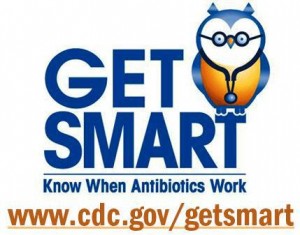23,000 Die Yearly of Antibiotic Resistant Infections
By Centers for Disease Control and Prevention // September 18, 2013
MORE JUDICIOUS USE OF ANTIBIOTICS IMPERATIVE
ABOVE VIDEO: CDC Director, Dr. Tom Frieden, highlights the new CDC report that covers one of the most serious health threats we face today – antibiotic resistance. The fact that our antibiotics don’t work as well as they used to, or at all, against a growing number of infections is alarming. We risk a future where simple infections can turn deadly. Cutting this threat requires urgent and immediate collaboration among public health, clinical medicine, agriculture, industry, and policy makers.
EDITOR’S NOTE: Antibiotics, powerful tools for fighting illness and disease, can be lifesavers, but misuse and overuse has increased the number of drug-resistant germs and created bacteria that are outliving the drugs used to treat them.
Antibiotic resistance is a rapidly progressing, extremely dangerous problem that affects everyone. In a recent Centers for Disease Control and Prevention (CDC) report, chronicled below in a CDC release, the agency detailed for the first time the toll that antibiotic-resistant microbes are taking on humans. Infections resulting from antibiotic resistance, such as methicillin-resistant Staphylococcus (MRSA), have been on the media forefront for well over a decade, but in this report the CDC takes a truly comprehensive look at over two dozen lesser known bacterial infections, ranking the threat of each as “urgent,” “serious” or “concerning.”
On the CDC’s “urgent” list are carbapenem-resistant Enterobacteriaceae (CRE), Neisseria gonorrhoeae, and Clostridium difficile.

Drug-resistant gonorrhea is the second most commonly reported notifiable infection in the U.S., responsible for some 800,000 cases a year, 246,000 of which are drug-resistant. There is grave concern that the easily sexually transmitted infection might become resistant to cephalosporins, especially ceftriaxone (Rocephin), the mainstay of first-line treatment. The CDC projects that progressive cephalosporin resistance would, over the next 10 years, result in 75,000 additional cases of pelvic inflammatory disease, 15,000 cases of epididymitis, and 222 additional HIV infections, as well as extra direct medical costs of $235 million.
In itself, the third organism on the “urgent” list, C. difficile, is not resistant to most antimicrobials used to treat it, but is definitely regarded as an unintended consequence of overuse of antibiotics. Although not included in the estimated 23,000 deaths associated with antibiotic resistance, the severe diarrhea and metabolic disturbance associated with C. difficile leads to approximately 14,000 deaths in U.S. hospitals annually.
Michael Jacobs, MD, of University Hospitals Case Medical Center in Cleveland told MedPage Today that red flags have been going up for years about antibiotic resistance. “The CDC report is a landmark because it’s the first really comprehensive look at the issue nationwide.” He points out that the problem has been growing for decades, and the new report is unlikely to make an immediate and sharp change. “Nothing is going to make a dramatic difference,” he said. “It’s going to be a long, slow struggle.

So, the CDC’s core action #3: “…The commitment to always use antibiotics appropriately and safely — only when they are needed to treat disease – and to choose the right antibiotics and to administer them in the right way in every case,” is the most important action needed to greatly slow the development and spread of antibiotic-resistant infections. Antibiotic stewardship, as it’s called, requires an enlightened, integrated and disciplined effort on the part of physicians, patients, pharmacists and healthcare policy makers.
CDC Details Today’s Drug-Resistant Health Threats
ATLANTA, GEORGIA — Every year, more than two million people in the United States get infections that are resistant to antibiotics and at least 23,000 people die as a result, according to a new report issued by the Centers for Disease Control and Prevention.
The report, Antibiotic Resistance Threats in the United States, 2013, presents the first snapshot of the burden and threats posed by antibiotic-resistant germs having the most impact on human health. The threats are ranked in categories: urgent, serious, and concerning.
Threats were assessed according to seven factors associated with resistant infections: health impact, economic impact, how common the infection is, a 10-year projection of how common it could become, how easily it spreads, availability of effective antibiotics, and barriers to prevention.
Infections classified as urgent threats include carbapenem-resistant Enterobacteriaceae (CRE), drug-resistant gonorrhea, and Clostridium difficile, a serious diarrheal infection usually associated with antibiotic use. C. difficile causes about 250,000 hospitalizations and at least 14,000 deaths every year in the United States.

“Antibiotic resistance is rising for many different pathogens that are threats to health,” said CDC Director Tom Frieden, M.D., M.P.H. “If we don’t act now, our medicine cabinet will be empty and we won’t have the antibiotics we need to save lives.”
In addition to the toll on human life, antibiotic-resistant infections add considerable and avoidable costs to the already overburdened U.S. health care system. Studies have estimated that, in the United States, antibiotic resistance adds $20 billion in excess direct health care costs, with additional costs to society for lost productivity as high as $35 billion a year.
The use of antibiotics is the single most important factor leading to antibiotic resistance. Up to 50 percent of all the antibiotics prescribed for people are not needed or are not prescribed appropriately.
Antibiotics are also commonly used in food-producing animals to prevent, control, and treat disease, and to promote growth. As in humans, it is important to use antibiotics in animals responsibly. To help ensure that medically important antibiotics are used judiciously in food-producing animals, the U.S. Food and Drug Administration recently proposed guidance describing a pathway for using these drugs only when medically necessary and targeting their use to only address diseases and health problems.
Antibiotics are also commonly used in food-producing animals to prevent, control, and treat disease, and to promote growth. As in humans, it is important to use antibiotics in animals responsibly. To help ensure that medically important antibiotics are used judiciously in food-producing animals, the U.S. Food and Drug Administration recently proposed guidance describing a pathway for using these drugs only when medically necessary and targeting their use to only address diseases and health problems.
“Every time antibiotics are used in any setting, bacteria evolve by developing resistance. This process can happen with alarming speed,” said Steve Solomon, M.D., director of CDC’s Office of Antimicrobial Resistance. “These drugs are a precious, limited resource—the more we use antibiotics today, the less likely we are to have effective antibiotics tomorrow.”
The loss of effective antibiotic treatments will also undermine treatment of infectious complications in patients with other diseases. Many medical advances—joint replacements, organ transplants, cancer therapy, rheumatoid arthritis therapy – are dependent on the ability to fight infections with antibiotics.
If the ability to effectively treat those infections is lost, the ability to safely offer people many of the life-saving and life-improving modern medical advances will be lost with it.
 To combat this serious health threat, CDC has identified four core actions critical to halting resistance:
To combat this serious health threat, CDC has identified four core actions critical to halting resistance:
- Preventing Infections, Preventing the Spread of Resistance: Avoiding infections reduces the amount of antibiotics that have to be used and reduces the likelihood that resistance will develop. Drug-resistant infections can be prevented by immunization, infection prevention actions in healthcare settings, safe food preparation and handling, and general hand washing.
- Tracking: CDC gathers data on antibiotic-resistant infections, causes of infections, and whether there are particular reasons (risk factors) that cause some people to get a resistant infection. With that information, experts can develop strategies to prevent those infections and prevent the resistant bacteria from spreading.
- Improving Antibiotic Use/Stewardship: Perhaps the most important action needed to greatly slow the development and spread of antibiotic-resistant infections is to change the way antibiotics are used. Up to half of antibiotic use in humans and much of antibiotic use in animals is unnecessary. The commitment to always use antibiotics appropriately and safely —only when they are needed to treat disease – and to choose the right antibiotics and to administer them in the right way in every case is known as antibiotic stewardship.
- Developing Drugs and Diagnostic Tests: Because antibiotic resistance occurs as part of a natural process in which bacteria evolve, it can be slowed but not completely stopped. Therefore, new antibiotics always will be needed to keep up with resistant bacteria, as will new tests to track the development of resistance.
To see the full report, please visit www.cdc.gov/drugresistance/threat-report-2013/. For more information about drug resistance and the serious impacts it has on human health, visit www.cdc.gov/drugresistance.












